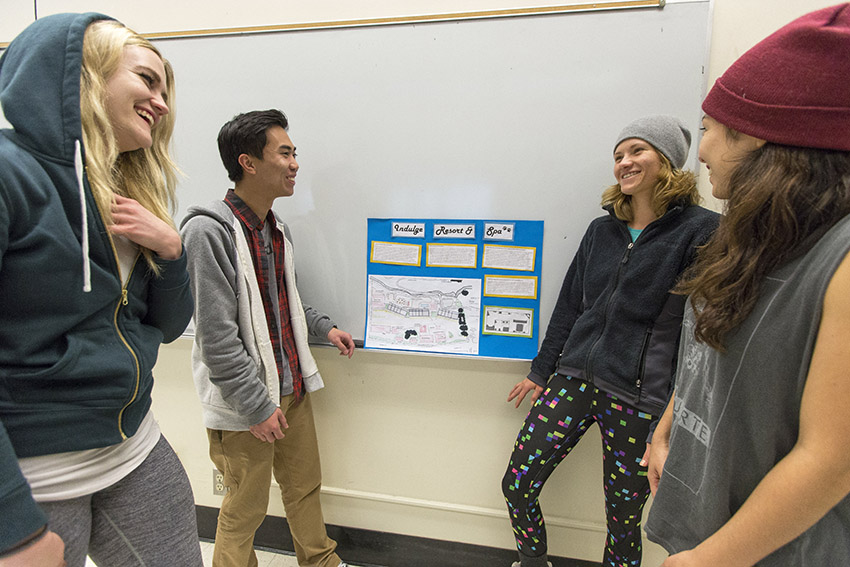Students get real-world insight by pitching their ‘Destination Resorts’

SF State students (from left) Lauran Well, Allen Siochi, Courtney Winterbauer and Cristina Navarro look at a final project for the “Recreation Destination Resorts” class at the School of Business on Dec. 8.
SF State partners with leading architecture firm for the 24th year
Ever envision what a boutique resort near San Francisco State University would look like? That’s exactly what students in Professor Patrick Tierney’s “RPT 460: Recreation Destination Resorts” class were tasked with creating for their final project. Students had the additional pressure of presenting their designs to professionals.
For the 24th year, the class, which is offered through SF State’s Department of Recreation, Parks, and Tourism (RPT), has partnered with architects from a Bay Area architecture firm, SB Architects. The course culminates with a visit from the architects in the classroom and a student presentation of their resort designs
The project allows students to apply the concepts they have learned in the classroom to a real-world scenario and connect directly with top industry professionals, both of which help them be better prepared for their careers.
SB Architects has designed a number of resorts in the Bay Area, as well as award-winning resorts in all parts of the world, including Calistoga Ranch in the Napa Valley, the Farmhouse Inn in the Sonoma Valley, Regis Bahia Beach in Puerto Rico and Malliouhana in Anguilla. Architects Greg Lehman and Keith Houchin spoke to students in Tierney’s class at the end of November and offered some professional insight into resort building.
SF State senior Lei Asato said what’s great about the Recreation, Parks, and Tourism major is how many times professors will bring in industry professionals who add a real-world view of their job. “And that helps you say, ‘I can be in that position one day because they started out once too and worked their way up,’” Asato said.
Scott Lee, president of SB Architects, said he knows how important it is to connect with professionals when you’re a student.
“It’s the difference between the academic world and going out and doing it,” Lee said. “It’s like reading about music, but until you actually hear it, it’s all academic.”
During their visit to the class, the architects discussed their work culture, their background and the latest trends in resort design. Students then had the opportunity to ask questions. At the end of the class, students presented their projects.
“We had some examples that Dr. Tierney provided throughout the semester, but it was up to us to have all the elements to make sure it was a functioning resort,” Asato said. “It’s really inspiring and supportive to know that there are industry professionals out there that you can network with once you graduate because you already got to know them through your professors.”
Presenting under that professional pressure was good practice for the real world, Asato added.
Some of the factors students considered when creating their projects were compliance with the Americans with Disabilities Act, traffic impacts, noise, sustainability and, of course, aesthetics.
“One of the core concepts we talk about in class is creating a unique experience for the guest and how the design of the resort continues that experience,” Tierney said. “Is it just a plain vanilla shake, or does it have some spices to it?”
A self-described “field trip” and “project-oriented teacher,” Tierney began searching for professionals who could lend some real-world relevance to his classes. In 1992, he ended up cold-calling the architecture firm, which was then known as Sandy & Babcock Architects. Company president and founder Donald Sandy said he’d love to participate. The partnership has stayed the same over the years, while much of the architecture world has evolved, and those nuances are woven into the architects’ presentation.
“Back in the day when we first started this, Don Sandy probably brought in drawings that he drew by hand. On their recent visit, Greg and Keith brought in movies that we made to communicate our ideas,” Lee said. “Where we used to just communicate in two-dimensional drawings, now we’re trying to touch all of the senses with motion and music and action, and we’re even taking that to the next level with virtual reality.”
This year the students followed up with a visit to the company’s headquarters near Pier 39, where they observed sophisticated 3-D modeling software and examples of design projects in progress and experienced a new resort design using virtual reality goggles.
“I’ve heard over the years the architects get ideas of trends and thoughts and resort concepts from the students,” Tierney said. “They are the young and represent their generation very well. It’s been a mutually beneficial relationship all these years.”